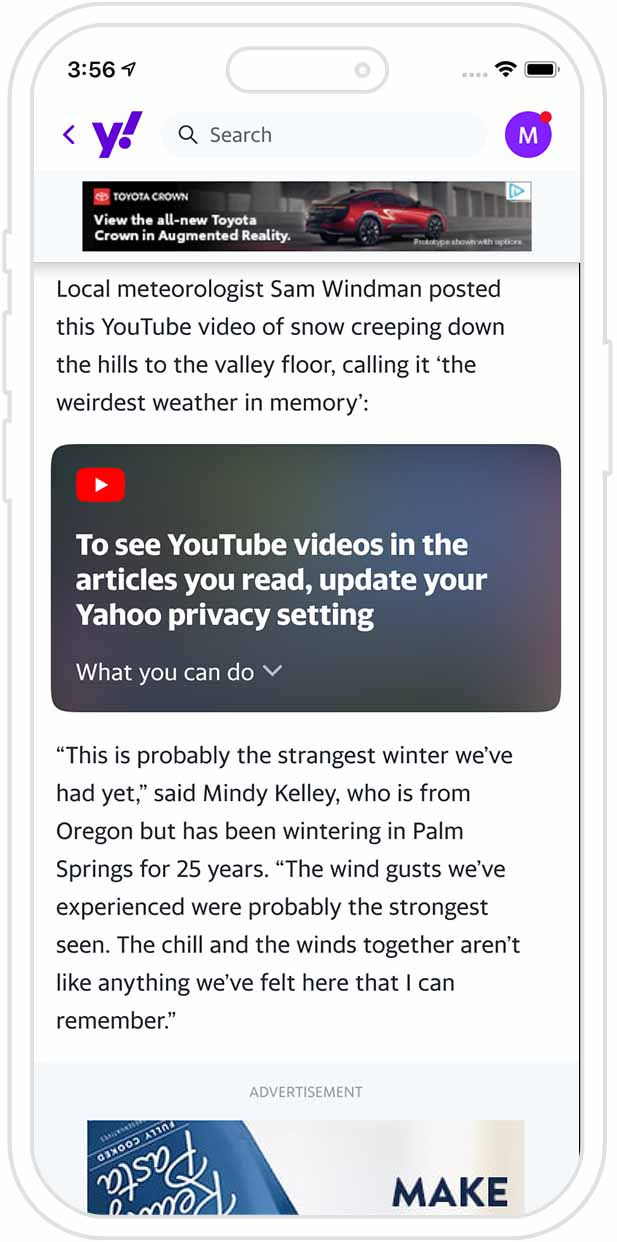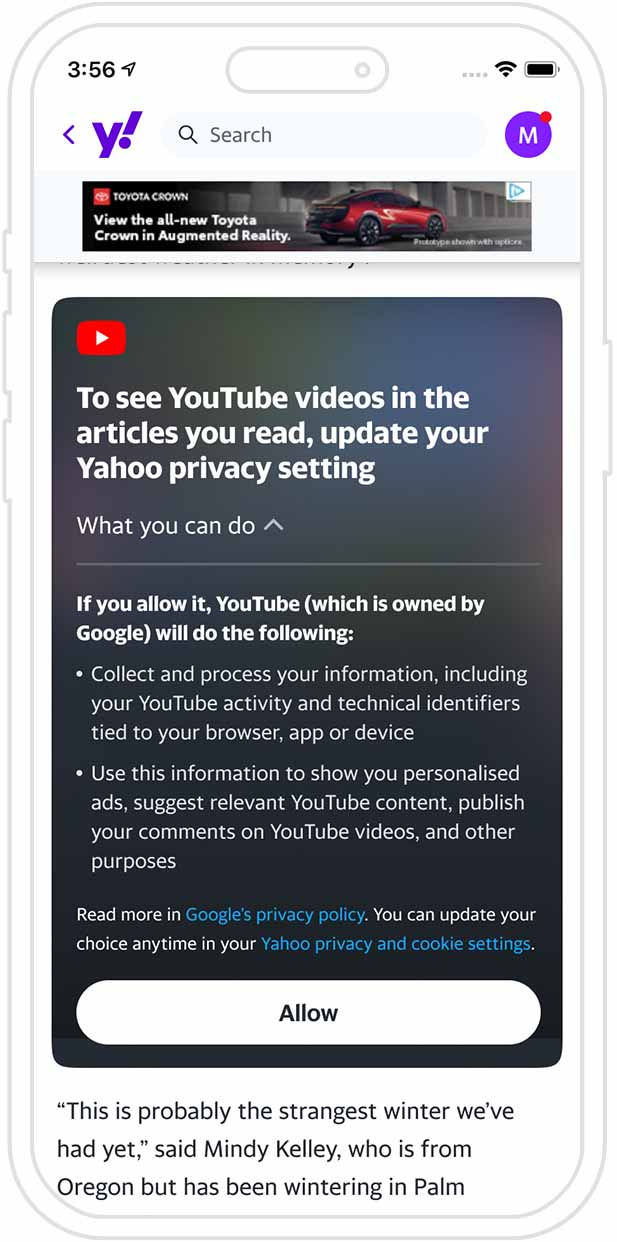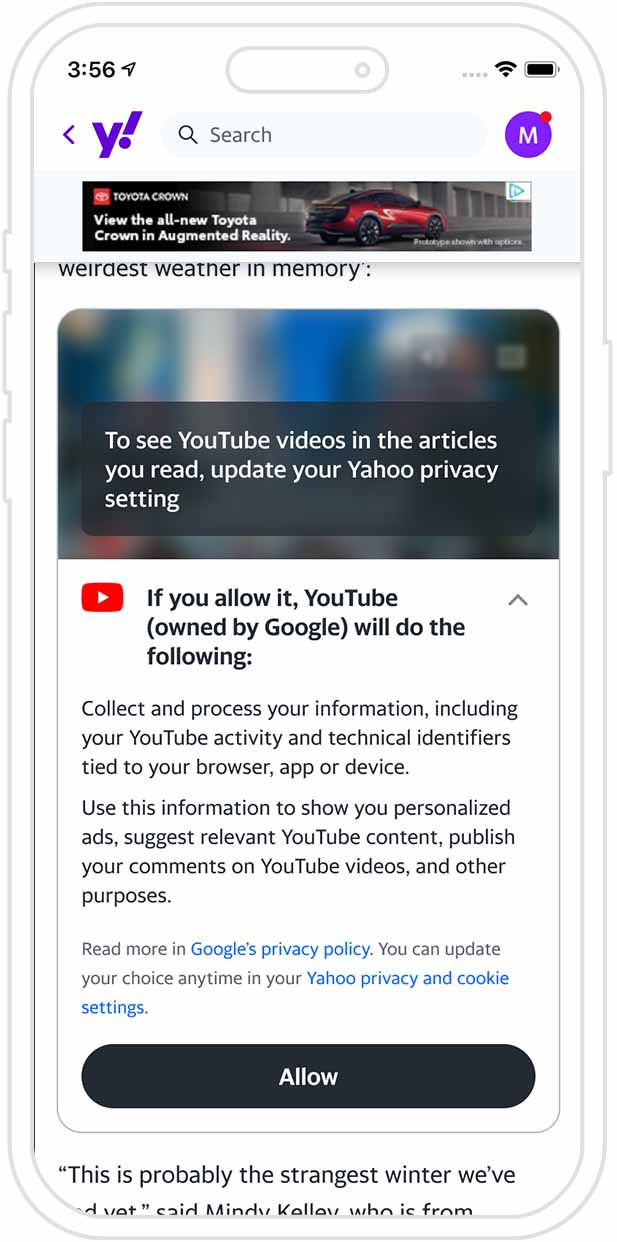Yahoo Partner Consent: Defining the Inline Privacy Compliance User Experience
Privacy regulations and partner requirements were reshaping how content could be delivered across Yahoo’s media brands. Embedded posts from Twitter and other third parties required explicit user consent, but the existing experience disrupted engagement and limited revenue. I led the strategy to balance compliance, user trust, and business performance.

Challenges
The original workflow forced users through a broken path: leaving the article, logging in, navigating complex Privacy Controls, and selecting consent options without context. Most abandoned the process, creating frustration and confusion.
This not only reduced engagement but also lowered consent rates, which directly impacted ad revenue tied to non-personalized data. The lack of clarity also exposed Yahoo to risk under GDPR and CCPA compliance.

Compliance: Users must meet partner requirements.

Redirected: Sent to a new Privacy Dashboard.

Consent Required: Must "Allow" to terms.

No Auto-Redirect: Users are not returned to the article

Manual Navigation: Must find the original page again
Research & Alignment
To ground the project, I focused on research and collaboration that would build cross-functional alignment and ensure the solution could scale. This work clarified user pain points, surfaced compliance risks, and provided a shared foundation for decision-making.
Competitive Analysis
Examined how peer platforms handled consent flows, identifying patterns of friction that led to drop-offs. This revealed opportunities for Yahoo to create a more seamless, user-first approach.
Design Workshops
Facilitated sessions with Legal, Privacy, Engineering, and Editorial leaders to surface pain points, clarify requirements, and align on objectives.
Guiding Principles
From this discovery process, I shaped the principles of Consent, Transparency, and Opt-Out Rights, which became the foundation of the design strategy.
Strategy & Principles
The goal was to reframe privacy compliance as an opportunity to strengthen trust, not a barrier to engagement. To guide the work, I established a set of principles that shaped the design direction and aligned stakeholders:
Consent — give users clear control over permissions.
Transparency — use simple, direct language without hidden settings or legal jargon.
Opt-Out Rights — ensure preferences could be revisited and updated at any time.
In parallel, I defined business objectives to measure success:
Enhance user engagement by keeping consent within the reading flow.
Generate revenue by enabling the use of non-personalized data
Strengthen brand trust and recognition through transparent practices.
Increase opt-in rates by reducing friction in the workflow.
Together, these principles and objectives framed the vision, aligned stakeholders, and created a shared understanding of how design would deliver both compliance and measurable business results.
Exploring and Testing
With the strategy in place, I guided the team through exploration and validation to determine which design direction best balanced clarity, engagement, and compliance.


Eye-Catching
A visually bold treatment that clearly signaled blocked content and drew attention. While engaging, it lacked specific guidance on what action users should take.


Big Logo
Leveraged strong branding to reduce uncertainty with clear messaging. However, the oversized presentation felt intimidating and failed to connect on a human level..


Full Copy
Offered comprehensive information upfront, giving users the full context of partner requirements. But the dense text overwhelmed users and created cognitive load.
After testing these variations, the “Eye Catching” approach proved to be the most effective. It quickly communicated the presence of blocked content, captured attention without intimidation, and provided a direct path to consent. This direction balanced user needs with compliance demands and became the foundation of the final design.

Approach
With validation complete, I directed the design toward an inline workflow that removed unnecessary redirects and reduced friction.
Key leadership contributions included:
Define Vision
Establishing that compliance should support, not disrupt, content consumption.
Cross-functional alignment
Partnering with Legal and Security to ensure GDPR/CCPA compliance without adding new friction.
Governance and scale
Embedding the consent pattern into Yahoo’s design system so it could be consistently applied across properties.
Overall Results
Outcome
The redesigned experience introduced inline consent prompts directly within the article. Instead of forcing users through a redirect and login sequence, the new flow allowed them to grant consent with a single action while staying in context. The solution was transparent, seamless, and adaptable across Yahoo properties. By creating a reusable pattern, the design not only solved the immediate problem but also laid the groundwork for handling future partner integrations consistently.
Impact
-
Drove a 7% lift in ad revenue by improving consent flow.
-
Increased trust and engagement by removing friction in the reading experience.
-
Established a scalable, compliant pattern that became the standard across Yahoo brands.
This project demonstrated how design leadership can turn regulatory challenges into opportunities, strengthening compliance, improving user experience, and driving measurable business outcomes at scale.






